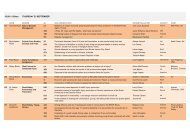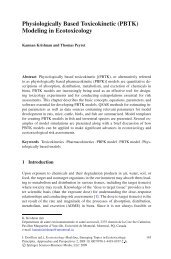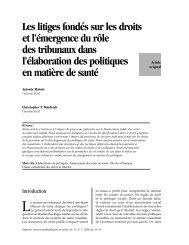Characterization of protective gloves stiffness: Development of a ...
Characterization of protective gloves stiffness: Development of a ...
Characterization of protective gloves stiffness: Development of a ...
Create successful ePaper yourself
Turn your PDF publications into a flip-book with our unique Google optimized e-Paper software.
1026 L. Harrabi et al. / Safety Science 46 (2008) 1025–1036<br />
constraints and reduced dexterity, two side-effects related to the glove’s material <strong>stiffness</strong> (Bishu and Muralidhar,<br />
1999; Buhmann et al., 2000; Cadoret and Smith, 1996). Furthermore, increased muscular constraints due<br />
to <strong>protective</strong> <strong>gloves</strong> have been associated to tendinitis (Chaffin et al., 1999). As a consequence, workers may<br />
choose not to wear <strong>protective</strong> <strong>gloves</strong>, exposing themselves to high risks <strong>of</strong> hand injuries.<br />
Stiffness is one <strong>of</strong> the major properties that define how a glove interferes with the worker’s ability to perform<br />
his tasks. Studies considering the biomechanical aspects <strong>of</strong> <strong>protective</strong> <strong>gloves</strong> use the effect <strong>of</strong> wearing<br />
<strong>gloves</strong> on the deployment <strong>of</strong> the maximum grip force (Kovacs et al., 2002; Mital et al., 1994; Nelson and<br />
Mital, 1995; Rock et al., 2001; Sudhakar et al., 1988). According to Mital et al. (1994), wearing <strong>protective</strong><br />
<strong>gloves</strong> reduces the maximum gripping force by 7–30%. A recent study confirms this interval (5–23%) for a<br />
whole range <strong>of</strong> glove models (Rock et al., 2001). However, this type <strong>of</strong> evaluation requires for the subject<br />
to exert several maximum muscular contractions, thus limiting the number <strong>of</strong> contractions in each measurement<br />
session and asking for very fit subjects. Moreover, procedures involving the use <strong>of</strong> human subjects are<br />
prone to high levels <strong>of</strong> inter individual variability, leading to large uncertainty in the measurements.<br />
Several mechanical test methods have been used for characterizing film and fabric flexibility. Most <strong>of</strong> them<br />
are based on uniaxial bending, which may not be representative <strong>of</strong> the type <strong>of</strong> deformations subjected to a<br />
glove in usage. For example, the Kawabata Evaluation System for Fabrics (KESF) includes a test measuring<br />
the bending moment <strong>of</strong> a strip <strong>of</strong> material as a function <strong>of</strong> its curvature, thus providing the uniaxial bending<br />
rigidity which is proportional to the material <strong>stiffness</strong> (Kawabata, 1980). On the other side, the test method<br />
used in the ISO 5979 standard (1982) measures the uniaxial flexibility <strong>of</strong> elastomer coated textile fabrics; its<br />
principle consists in forming a loop with the material, the maximum height formed by this loop being proportional<br />
to the material <strong>stiffness</strong>. Finally, in the ASTM D 1388 standard (1996), which characterizes the flexibility<br />
properties <strong>of</strong> fabrics, the bending length is measured according to two procedures, the cantilever test and<br />
the heart loop test, which allows the flexural rigidity to be calculated.<br />
When <strong>protective</strong> <strong>gloves</strong> are worn, they are subjected to uniaxial deformations as well as equibiaxial ones, as<br />
can be seen in Fig. 1. Stiffness measured with a uniaxial deformation test may not describe well the glove performance<br />
in service. <strong>Characterization</strong> methods making use <strong>of</strong> multidirectional deformations are thus required.<br />
The test method used in the ASTM D 4032 standard (1994) makes use <strong>of</strong> a circular bend procedure for<br />
measuring the <strong>stiffness</strong> <strong>of</strong> fabrics, thus creating multidirectional deformations. A flat headed cylindrical probe<br />
forces a folded piece <strong>of</strong> the fabric sample through an orifice in a platform. The maximum force required to<br />
push the fabric through the orifice is measured and can be used as an indication <strong>of</strong> the fabric <strong>stiffness</strong>. Some<br />
authors have calculated the work corresponding to the entire passing <strong>of</strong> the piece <strong>of</strong> fabric through the orifice,<br />
which is proportional to the material <strong>stiffness</strong> (Killinc-Balci, 2004). However, the much larger thickness <strong>of</strong><br />
<strong>gloves</strong>, in particular considering the presence <strong>of</strong> fingers, prevents the use <strong>of</strong> this method as it is. In addition,<br />
the flat headed shape <strong>of</strong> the probe does not generate deformations typical <strong>of</strong> what is sustained by <strong>gloves</strong> in use<br />
and may create unnecessary stress concentration.<br />
In this study, we propose a new multidirectional test method, inspired from the ASTM D 4032 standard<br />
method, which allows for the measurement <strong>of</strong> <strong>protective</strong> <strong>gloves</strong> <strong>stiffness</strong>. This new method is described below<br />
as the free-deforming multidirectional technique and has been used to measure the <strong>stiffness</strong> <strong>of</strong> 28 models <strong>of</strong><br />
Fig. 1. Folds (a) and biaxial deformations (b) <strong>of</strong> worn <strong>protective</strong> <strong>gloves</strong>.













